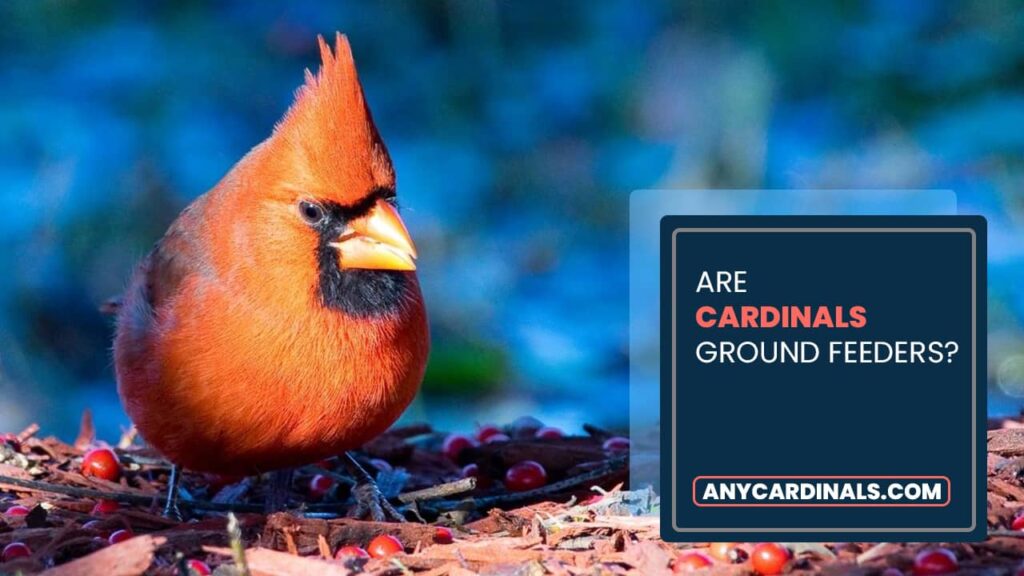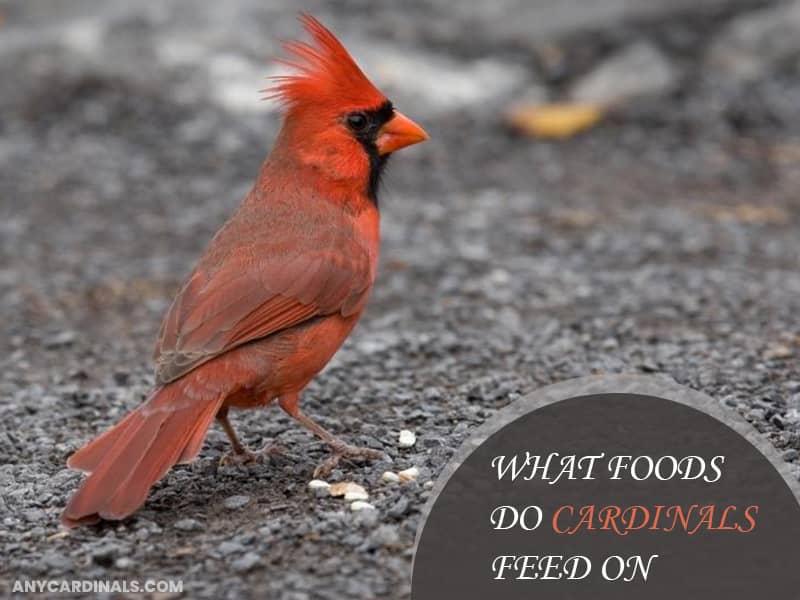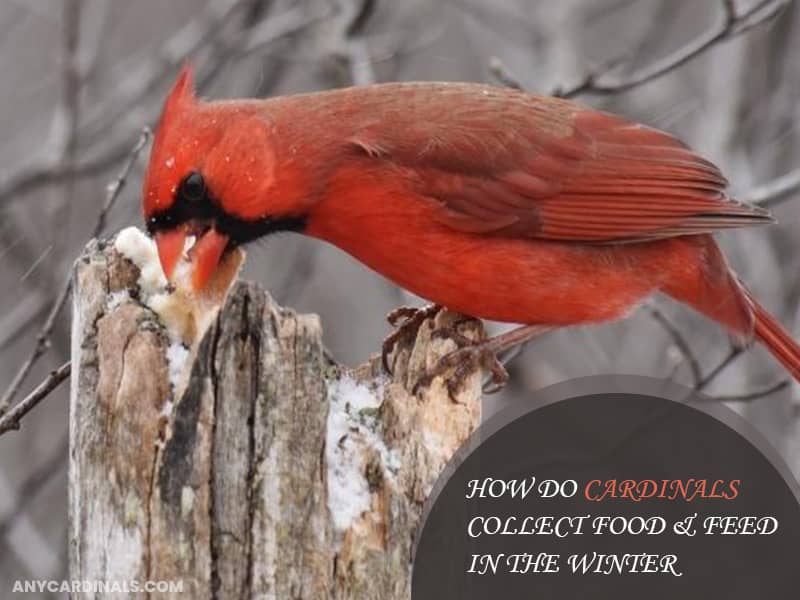Are Cardinals Ground Feeders That Eat on Land?
Like cardinals’ awe-inspiring feathers, their eating traits stimulate curiosity among bird watchers.
Their feeding deportment makes birders ruminate on various questions like are cardinals ground feeders? Yes, cardinals are ground feeders like most other birdies, and they forage insects and seeds from the grounds, trees, bushes, and in flight. And they will munch on literally everything edible for birds.
That said, this blog post is all about cardinals’ food sources and other information related to their feeding trait. So, without waiting more, let’s read on.

Here’s another interesting blog for you:
What Foods Do Cardinals Feed On?
Cardinals enjoy a diverse diet, especially in spring and summer. Their meals are about 30% insects and 70% grains, seeds, greens, and fruits. They devour beetles, termites, grasshoppers, caterpillars, spiders, cutworms, and other insects.

When it comes to fruits, northern cardinals love raspberries, mulberries, elderberries, strawberries, blueberries, blackberries, cherries, apples, crabapples, grapes, and dried serviceberries.
As for seeds, cardinals favor sunflower seeds, safflower seeds, squash seeds, black oil sunflower seeds, box elder seeds, muskmelon seeds, ragweed seeds, and weed seeds.
They also eat rice, corn, oats, tree nuts, flower blossoms, buds, suet, buckwheat, millet, peanut butter, maple sap, bread crumbs, and more. Cardinals are nearly omnivorous in their tastes.
In fall, they prioritize high-energy seeds and berries to build fat reserves for winter, per Cornell Lab.
Where Do Cardinals Forage for Food?
Cardinals are adaptable foragers, often seen hopping on the ground to pick up fallen seeds or insects. They also perch on low shrubs or tree branches to pluck berries and buds.
In urban areas, they frequent lawns and gardens, scratching at soil to uncover hidden morsels. In forests, they explore undergrowth and leaf litter for food.
Their strong beaks crack tough seed shells, allowing them to exploit varied food sources across habitats, per Audubon Society.
How Do Cardinals Collect Food & Feed In The Winter?
FYI, cardinals are non-migratory birds; instead of leaving their habitats, they stick around and forage for food in winter. Usually, at the beginning of winter, cardinals get water and foods like fruits and insects from snow.
But during the end of winter, it gets challenging for cardinals to collect food as ponds, lakes, trees, and nearly every natural food source get frozen. Thus, cardinals need to deal with food scarcity.

Anyway, here are a couple of steps you can take as a birder to help these birdies survive winter. You can hang one or more bird feeders filled with seeds and fruits in your backyard.
Plus, you can place a birdbath with a heater and attach a de-icer to ensure that cardinals receive clean and warm water during the winter.
But your duty doesn’t end here; you should regularly clean the bird feeders and birdbath and refill them with seeds and clean water after a few days. In this way, you can prevent cardinals’ extinction.
They often visit feeders more frequently in late winter, relying on human-provided food sources, per Audubon Society.
What Types of Feeders Do Cardinals Prefer?
Cardinals are picky about feeders due to their size and feeding style. They prefer platform feeders, which allow them to perch comfortably and access seeds easily.
Hopper feeders are another favorite, offering protection from weather and predators. Tube feeders with large perches also work if filled with their preferred seeds.
Avoid feeders with small perches, as cardinals need space to balance while eating, per Cornell Lab.
Frequently Asked Questions:
01. What Time Of Day Do Cardinals Feed?
Cardinals typically feed at dawn and dusk, maximizing energy intake. However, they’ll eat throughout the day if hungry, following no strict schedule.
Morning feeding peaks align with their high metabolic demands after overnight fasting.
02. Can You Hand Feed Cardinals?
Hand feeding cardinals is possible but tricky, especially in suburban areas where they’re cautious. Ornithologists advise against it, as it may make them aggressive or overly dependent.
Regular hand feeding can disrupt their natural foraging instincts, reducing survival skills.
03. Can You Feed Cardinals Bread?
Cardinals eat bread, bread crumbs, oats, wheat, and other human foods, even spiders when desperate. They avoid dairy, though. Bread should be a rare treat, lacking vital nutrients.
Overfeeding bread can lead to malnutrition, weakening their immune systems.
04. How Can You Attract Cardinals to Your Backyard?
To draw cardinals, set up platform or hopper feeders with black oil sunflower seeds, safflower seeds, or suet. Place feeders near shrubs or trees for safety.
Add a heated birdbath in winter and a regular one in summer to provide water. Plant native shrubs like dogwood or sumac, which offer berries and shelter.
Keep your yard pet-free, as cats and dogs can scare cardinals away. Consistency in feeding and a safe environment will make your yard a cardinal hotspot.
Dense cover, like evergreen shrubs, boosts their confidence to visit regularly, per National Wildlife Federation.
Wrapping Up
Cardinals are inclusive eaters, and they love to consume varied foods, whether these foods are on the ground or up in the trees. So, although they are known as ground feeders, it doesn’t necessarily mean they will continually search for foods and consume them from the ground.
That’s all for this article; we hope this one also provides valuable information on cardinals like our other blog posts. However, if you prefer reading more articles like this, you can stay connected with us on Twitter and Pinterest.

